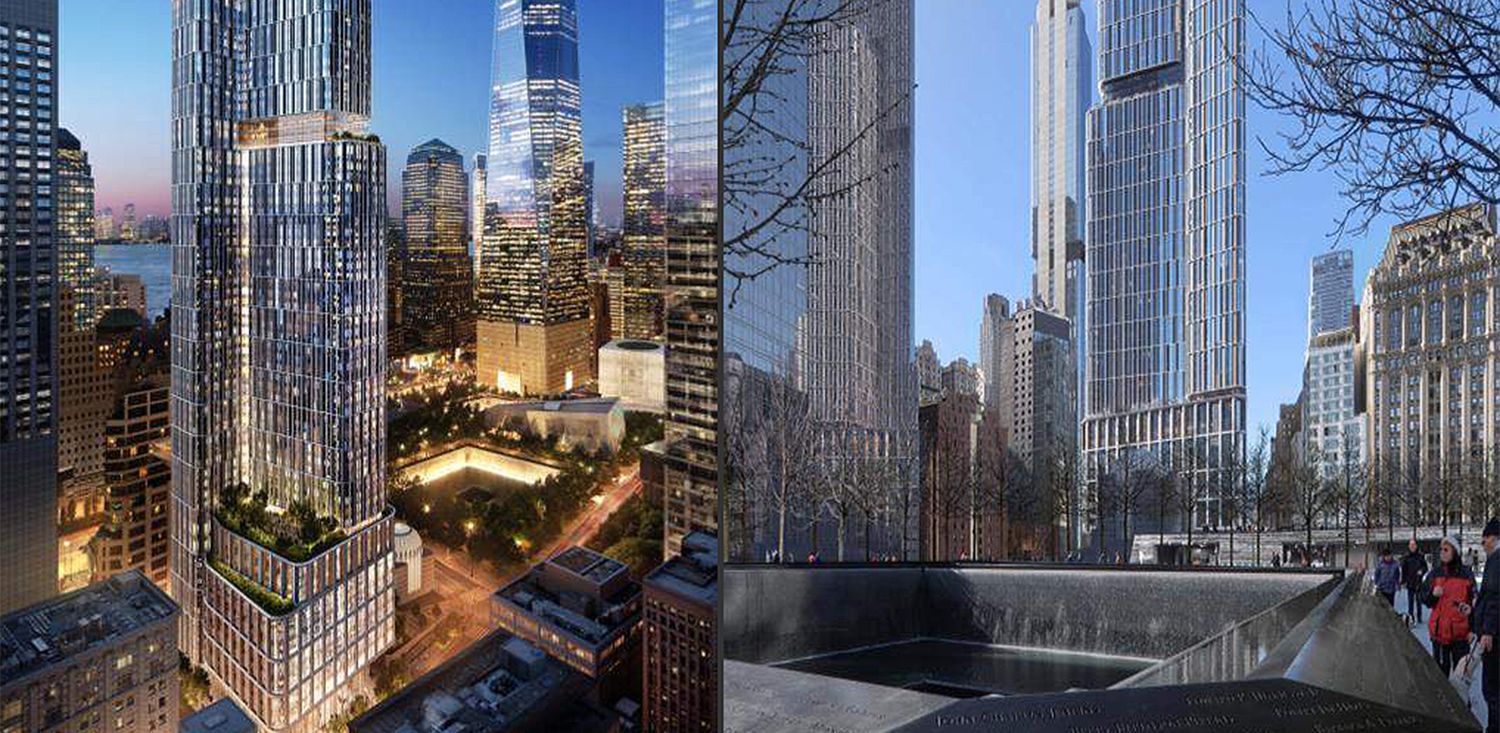With the mania to build government-subsidized luxury apartment towers in Lower Manhattan — even as many sat empty or entered foreclosure before COVID-19 — one might assume that the decision to let Silverstein and Brookfield build a residential complex at 5 World Trade Center, the last public lot at the attack site, is just another example of the superrich’s preoccupation with glass boxes.
However, deeper investigation reveals that the tower proposal is a sideshow to the main event at the World Trade Center. While of course the bidding process begun in 2019 was inadequate and Silverstein and Brookfield are likely to receive extremely favorable lease terms to consolidate a new Hudson Yards, the rush to complete this transaction has another purpose. It is part of a larger scheme to transfer public property to two notoriously opaque and wasteful private entities: the September 11 Memorial and the Downtown Performing Arts Center, both controlled to a significant degree by former mayor Michael Bloomberg. With the Port Authority of New York and New Jersey in a politically weakened state, any plausible offer, despite lacking any proper and publicly-accessible appraisal of the trade value, might be enough to force giving away some of the world’s most valuable real estate at the World Trade Center complex (possibly including lucrative air rights). The key institutional player, the Lower Manhattan Development Corporation, is betting on secrecy, weak federal oversight, community board acquiescence, crippled local media, and an overburdened public. However, while they may be able to handle a debate about the ratio between luxury and affordable housing in the complex, determined scrutiny into the overall deal could kill it.
5 World Trade Center (130 Liberty Street) was originally Bankers Trust Plaza, a 39-story skyscraper that opened in 1974. Later the headquarters for Deutsche Bank, it was heavily damaged during the September 11 attacks, and, afterward, the Lower Manhattan Development Corporation, the quasi-public entity created to spend federal disaster funds, was tasked to administer its purchase, decontamination, and demolition. The goal was to make this site the first completed post-September 11 project: a new headquarters for JPMorgan Chase. This deal was eventually canceled, and like everything else associated with the World Trade Center, the effort became a mess.
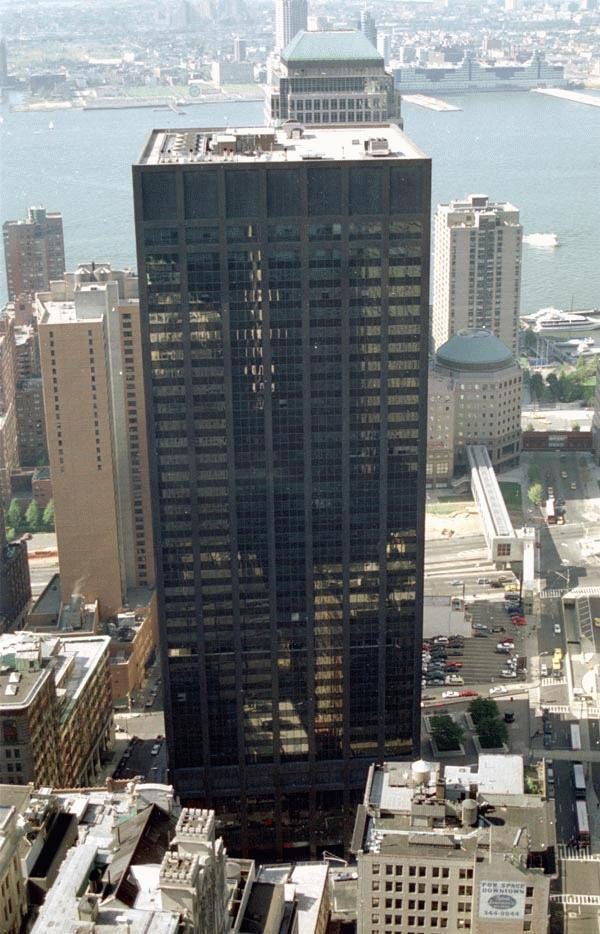
Deutsche Bank building, from Wikipedia.
In fact, the demolition itself ended up being a complete nightmare that was not completed until a decade after September 11. The LMDC, as an ad hoc entity controlled by politicians, had no experience administering a demolition. Opposing local residents and some regulators, they decided to engineer the site’s demolition and decontamination simultaneously. This led to logistical problems that caused endless delays and difficulties with corruptly-chosen contractors (at least one of whom was reported to be mafia controlled). In August 2007, when a fire broke out, the LMDC’s mismanagement led to actual injury and death, as inexperience, secrecy, and negligence combined to suspend fire department inspections, meaning that there was not proper fire safety for materials or a working water standpipe. Two firefighters died and dozens of others were injured, triggering years of lawsuits. Joe Graffagnino, the father of one of the firefighters, has even written an entire book that focuses on the LMDC’s responsibility for the fire.
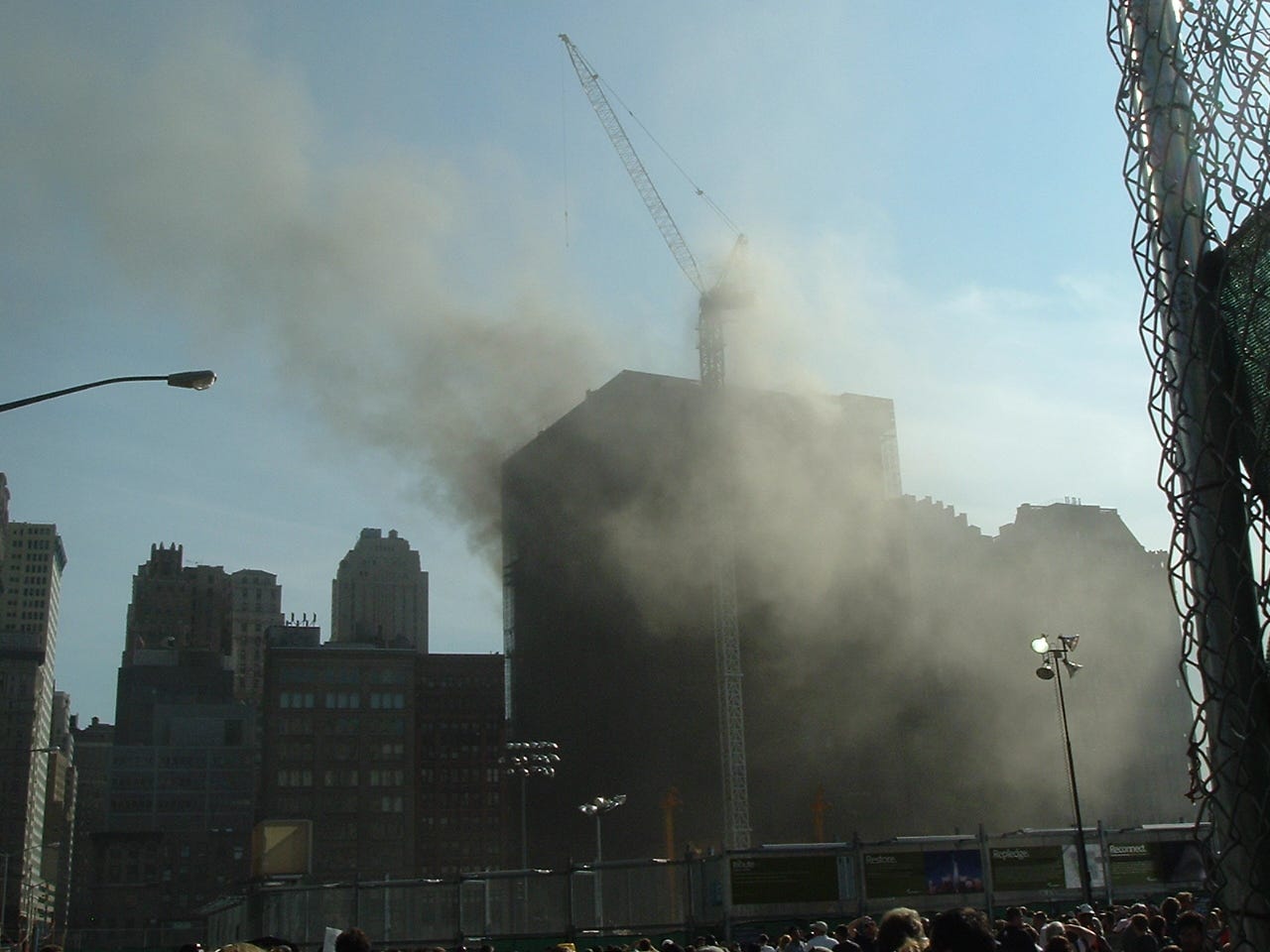
Deutsche Bank bank fire, from Wikipedia.
One might think that after such a record of incompetence and negligence, the Lower Manhattan Development Corporation would be asked to shut down and never touch anything associated with the Deutsche Bank site ever again. However, in the contemporary politics of New York City, failure often propels upward, and loyalties to the governor and mayor mean more than competence or the public interest.
Able to shovel billions of dollars to politically-favored projects, the Lower Manhattan Development Corporation continued to lick its lips for years to receive even more revenue or property in-kind from their purchase of the Deutsche Bank site with federal funds. In 2006, before the fire, the LMDC signed a Memorandum of Understanding with the Port Authority establishing that the site could potentially be traded for even more valuable land associated with the Performing Arts Center and the September 11 Memorial. The boards of these nonprofits and the Lower Manhattan Development Corporation overlapped substantially, and these organizations would consume hundreds of millions of dollars of LMDC-administered grants toward exorbitant executive salaries and some of the most wasteful and delayed construction projects in world history. However, profligate grants were not enough; the LMDC wanted to engineer a windfall gift of the attack site itself (preventing it from becoming a national or state park). Looking closely into their reports and funding statements, one would be hard-pressed to consider LMDC as anything but a front for a collection of massive, profligate “nonprofits.”
Technically, however, the Lower Manhattan Development Corporation had transferred the title to Port Authority for the Deutsche Bank site before these lucrative land transfers could be completed. Meanwhile, the Port Authority began to speak about a future office building at what they called “5 World Trade Center,” similar to the other properties in their “campus.” This longer-term vision solidified as various political and operational disputes between the Port Authority, and the September 11 Memorial supported by LMDC, meant that the property transfers were not expedited and Port Authority held the cards.
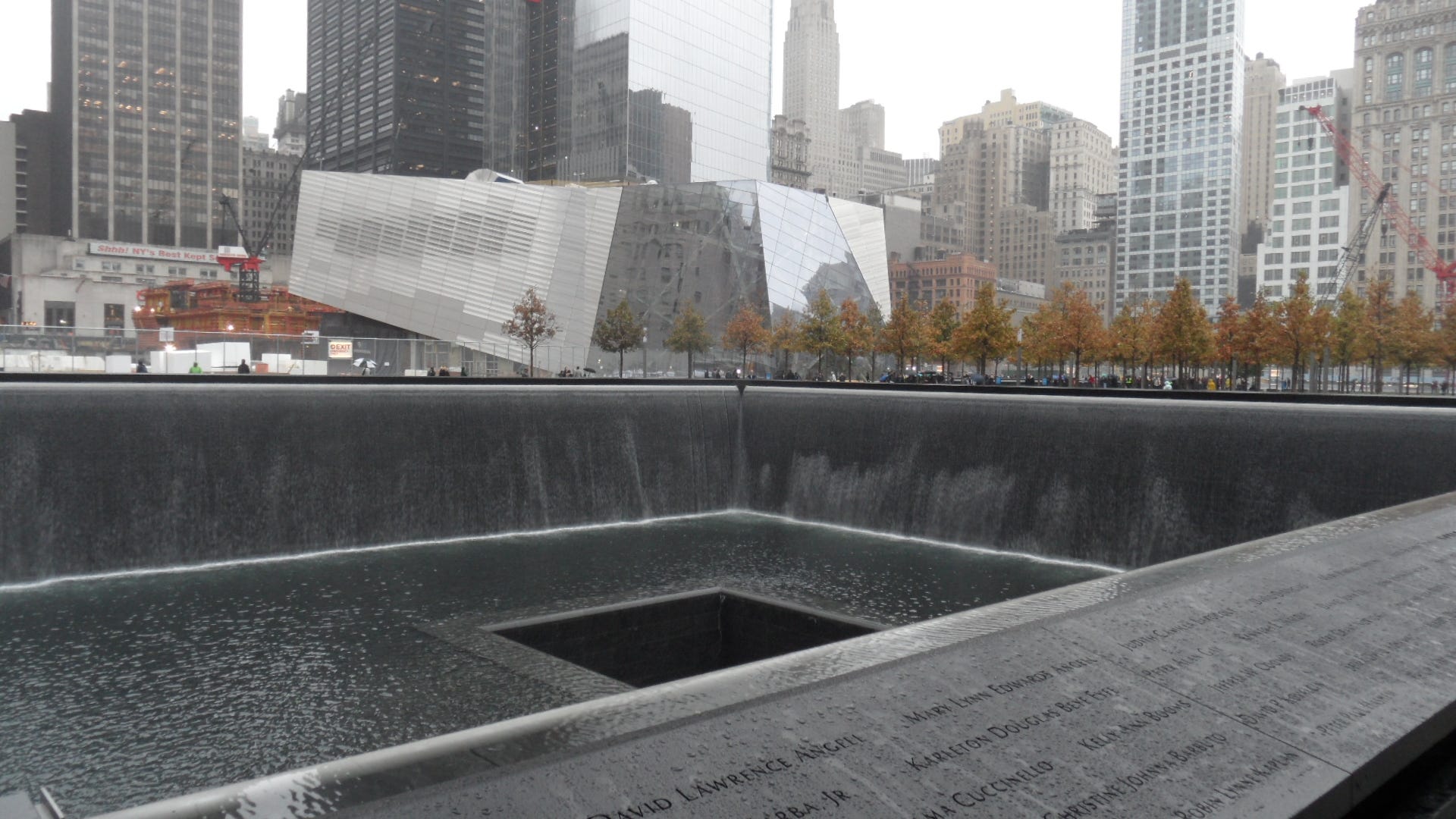
September 11 Memorial, from Wikipedia.
Increasingly, with growing frustration after wasting funds on the demolition and subsequent lawsuits after the fire, the LMDC began to complain about the Port Authority and demand that 5 World Trade Center be developed as a residential property, with the proceeds presumably being transferred back to the Memorial, the Performing Arts Center, and other favored partners. The LMDC conceded it had earlier given up its claim of ownership, but it was determined to make enough noise to bring in more money.
In 2018, after a corruption scandal led to new leadership at the Port Authority in August 2017, a bargain was reached. The new Port Authority was willing to try to maximize immediate revenue for LMDC from a sale of 5 World Trade Center, but only if it could first be compensated for its value as a commercial property.
A triparty MOU dated March 2019 (PA, LMDC, and City government) reveals the arrangement. Dual appraisals for the value of the site as commercial property were done by LMDC and Port Authority. If the appraisals were comparable, an open RFP for both residential or commercial purposes would be floated, and, if a winning residential proposal accounted for more revenue than the commercial appraisal, LMDC would receive the additional proceeds. The Port Authority had said that since it was not allowed to be involved in residential projects by law, the land would have to be sold rather than leased.
Given that the complex RFP in June 2019 had a quick turnaround of three months and only five proposals were received for some of the most interesting real estate in the world, it seems likely that the powerhouse duo of Silverstein Properties and Brookfield Properties were already in the know and had been preparing for some time. I saw their heavy preparation and dominant presence in the flesh during the in-person information session on July 22, 2019.
Yet, COVID-19 threw everything up in the air, and the RFP result was not announced for a year and a half until 2021. The future viability of luxury residential towers in Manhattan is uncertain, and there is a crisis need to use all available public land for deeply-affordable housing. LMDC might have worried about making a tone-deaf announcement in such an environment. Or they had doubts about the viability of private financing at the pre-COVID offer prices. Nevertheless, the LMDC, which had engineered the process to give them more votes on the selection committee than the Port Authority, was determined to see this through.
The announced result on February 11, 2021, unsurprisingly, was the luxury residential tower by Silverstein and Brookfield, which completes the World Trade Center’s conversion into something similar to Hudson Yards. An alliance between the two companies will bring the type of monopoly forces to the World Trade Center that Related Co. and Howard Hughes Corporation have been experimenting with, integrating residential, office, retail, and entertainment into an Orwellian “controlled” neighborhood. Obviously, this is a complete betrayal of the public listening sessions after September 11 in 2002 and 2003, when thousands of participants said that September 11 was “an attack on all New Yorkers” and that federal funds should not be used to benefit the rich with speculative luxury schemes. The LMDC was supposed to work to develop new affordable housing, but it did very little, even never completing, or at least releasing, a report on affordable housing on Lower Manhattan it had solicited through an RFP.
The announced result for 5 World Trade Center also has questionable legality. Rather than a sale as the MOU dictated, it was announced as a lease. The state-run Empire State Development Corporation will possess the land and give all proceeds to the Port Authority, believing that this unconventional arrangement can resolve the legal restrictions for the Port Authority being involved with residences.
While the overall deployment of federal funds is outrageous on several levels, contemporary Manhattan is filled with outrageous projects on public land or incentivized through tax policy. What makes this project unique is that its true purpose is an even more outrageous, little-known act: transferring public land to the September 11 Memorial and the Performing Art Center, possibly including air rights as well. Apparently, the lease revenue paid by Silverstein and Brookfield is low enough that the LMDC, which had been shouting about the more lucrative residential option for years and years, will receive absolutely nothing. Instead, the interests of its nonprofit partners are its primary concern. In their board meeting on February 11, 2021, the LMDC stated that they were seeking to expedite these land transfers.
There is no reason these organizations should need such gifts as both projects have sold out to billionaires. The September 11 Memorial is almost entirely controlled by Michael Bloomberg, who lords over almost every key decision, even when inexplicable to the families of the victims. The Downtown Performing Arts Center, also chaired by Bloomberg, has now decided to name itself “The Perelman,” after Trump-backing billionaire banker Ronald Perelman. After receiving hundreds of millions of dollars of public funds, could we imagine a more insulting decision? And if these entities are so willing to accommodate billionaires, shouldn’t they be satisfied with just a lucrative (perhaps one dollar) 99-year lease to the land they stand on? Do they also need to finance their operations with collateralized loans or sales of air rights?
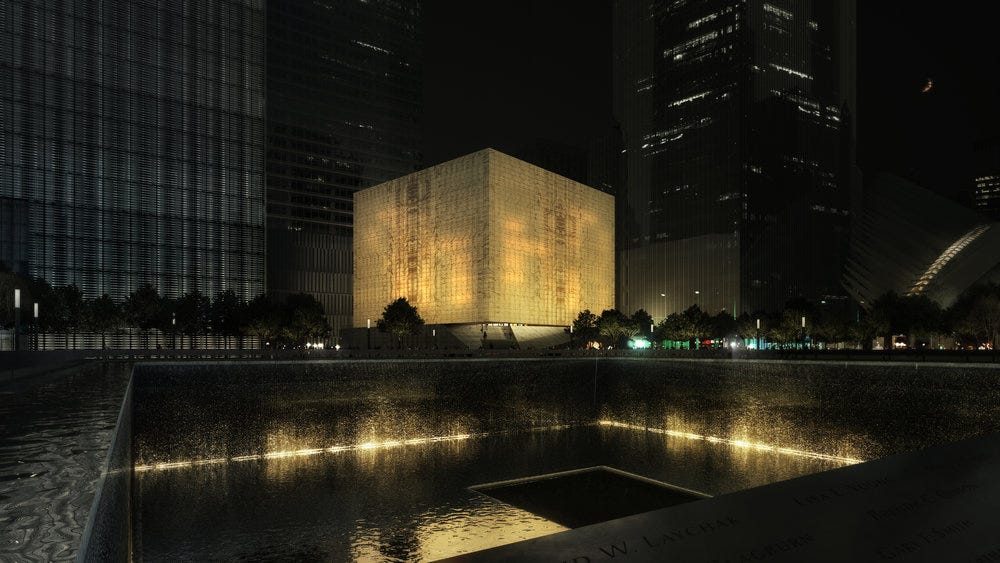
“The Perelman,” LUXIGON
As of yet, not a single politician has asked whether, at a time of hemorrhaging funds at Port Authority, it is appropriate to transfer billions of dollars of value to two private entities. No one has asked for a fair accounting of this trade value, or whether it is appropriate to build luxury apartments at the World Trade Center just so we can facilitate further public-private transfers. LMDC even asked the Trump administration to waive grant administrative and reimbursement requirements for this transfer under 24 CFR § 570.489(j), which certainly the Biden administration’s Department of Housing and Urban Development needs to reverse.
The Washington Street Advocacy Group supports a new course and asks for the public to get involved.
First, as September 11 families have long demanded, the September 11 Memorial should become a national park administered by the National Park Service and the Department of Interior (who are already being asked to provide perpetual grants supported by congressional legislation). This would ensure democratic input and responsible use of federal funds. The September 11 Memorial fired much of its staff during COVID-19, even after charging twenty-six dollars for museum tickets. Long-term stability, as well as affordability for families who aren’t rich, can be better offered by federal management than a one-time taxpayer gift that might be misused. A transfer of property from the Port Authority to the federal government could be funded by taxpayers who want to visit the memorial site in perpetuity and a modest price would be compensation for the many years of wasteful spending at the World Trade Center. This act would ensure that the land remains in public ownership.
Simultaneously, the Performing Arts Center does not need to own its land outright unless its governance structure is intentionally shaped by the public to ensure long-term public benefit. The board of directors needs to be reformed to ensure that all expenditures benefit smaller artists and community entities. If public funds are largely used to create an entertainment venue controlled by the wealthy for large corporate performances, then the project will be a failure that only competes with other venues like any other business. If it is going to act like an opaque business supported by a billionaire namesake, it should be able to fundraise and lease or purchase its location.
Second, the 5 World Trade Center RFP should be redone with new selection criteria that encourage deeply-affordable housing or public uses such as a university or hospital. The original criteria had become meaningless with COVID-19, and it was already clear that the luxury residential market had become a dubious speculative mania on its way out.
This is the last decision at the World Trade Center site and the last chance to correct a two-decade process of greed, waste, incompetence, and corruption. Boosters don’t like to hear this, but the area has become alien to most New Yorkers as a corporate-controlled wasteland. A different outcome that prioritizes the public interest might be able to redeem the World Trade Center.
Because LMDC actions need to be validated by the Department of Housing and Urban Development (HUD), the Biden administration has an extraordinary opportunity to reject these uses of federal funds and seize this issue as a centerpiece of its new policies on social and affordable housing. With the 20th anniversary of September 11 approaching, if the federal government rejects this corrupt deal by LMDC and explores making the attack site a national park that borders deeply-affordable housing at Site 5, the administration could inspire the world.
Todd Fine is the President of the Washington Street Advocacy Group, an organization that advocates for historic preservation of the “Little Syria” neighborhood in Lower Manhattan and for the memory of its writers like Kahlil Gibran and Ameen Rihani. He has worked with the City of New York and the “Percent for Art” program to develop a proper memorial for Arab-American literary heritage in the new Elizabeth Berger Plaza. He holds a BA in government from Harvard University (2004) and an MA in international relations from the Maxwell School of Citizenship and Public Affairs at Syracuse University (2007). He is a PhD candidate in history at the CUNY-Graduate Center.
